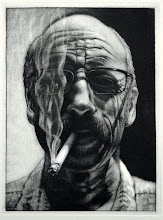

Annie McCollum, a BFA Drawing major, will be part of the 2009 BFA Senior exhibition that will open on April 2nd. She's hard at work getting a body of drawing completed and ready by that time. Her drawings are exploring conservation and endangered species. The above is the beginning of one of those pieces, a large Salamander. When that little critter is complete, she'll cut it from its current context and essentially add it to another large scaled drawing. That image will be one in a group of interesting drawing constructions.
The other image is Connie Goodwin's hand at work on a reductive charcoal drawing from the F100 class. They've been working with charcoal this week. On Monday Connie wasn't very excited about the medium; today she was!

I need to look up some things for my Photoshop class tonight Brian. And the internet connection here is a bit slow so I can't do both. But, if you would like tomorrow I'll be happy to take a picture of what we were doing and attach it to my Photobucket account and post it here.
ReplyDeleteI really liked the reverse technique. I'm one of those 'immediate gratification' people and it was a lot of fun having the color there and taking it away to create the image. I know that's something I'll play more with in the future.
The neat part too was as I looked at everyones pictures in class it didn't seem to matter the skill level. They all came out quite nice. So, I think it's really a great technique for some of us beginners to have something we can show to friends and family that doesn't look quite as simplistic. My husband saw that one and said he really liked it. I think I'll frame it. Of course, years from now I'll probably look back and laugh a bit. :)
Rather than "color", it was actually a value. Charcoal toned paper produces a value of grey, unless it's colored paper, of course. Reduction drawings can be very satisfying since we're starting with a medium value that easily establishes a workable field within the drawing. The process also enables us to understand the potentials of our erasers as drawing tools. Pushing an image back and forth through that field also helps to increase our understanding of the wide range that values can achieve and their impact on imagery. Glad you enjoyed it.
ReplyDeleteI agree with what Connie said. The reduction drawings are a lot of fun to do, even if I'm covered in caracole by the time I'm done.
ReplyDeleteI can now say that I am better at drawing with charcoal. Connie is this your first or second drawing? It is very good.
ReplyDeletei agree your drawing is very nice.
ReplyDeleteThank you. I had a lot of fun doing it. We did similar today with the graphite and I'm finding I think I like the charcoal a bit better.
ReplyDeleteIt's pretty cool looking at my first drawings and already seeing some improvement. Are the rest of you noticing improvements in your skills as well?
Brian, I hope you don't mind. I put that picture of my hand on the group I created on Facebook for the Fine Arts students. I just thought it was really cool picture.
ReplyDeleteI really like the Salamander drawing. I was looking at it with my son and he said that it looks so real.
ReplyDeleteI really like this picture. The lizard actually looks wet. I think that the shine really makes it look alive. Did you just use your eraser to create taht?
ReplyDelete